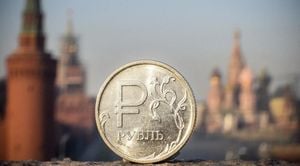Russia’s currency has hit another rough patch, with the ruble experiencing significant losses against major currencies this past week. Falling to lows not seen since the early days of the conflict with Ukraine, the ruble’s rapid decline poses new challenges for the Russian economy, which is already grappling with the effects of international sanctions and hefty defense spending.
On November 29, 2024, Russia's central bank pegged the exchange rate of the ruble at 109 to the U.S. dollar, having bounced back slightly from week-low values approaching 114. Just two days earlier, the ruble saw its worth plummet by ten percent against both the dollar and the yuan, marking nearly 25% loss compared to its summer highs. This recent volatility draws stark parallels to the panic witnessed back in March 2022, shortly after the full-scale invasion of Ukraine.
The rapid decline of the ruble is attributed to several interconnected factors. U.S. sanctions on the Russian financial sector have tightened both liquidity and the overall currency market structure. A recent round of sanctions targeted over 50 banks, including state-owned institutions, which previously managed foreign payment flows for Russian gas exports. The sanctions particularly impacted Gazprombank, which had been one of the last major financial institutions to escape U.S. scrutiny. Now, without this lifeline, Russian exporters face difficulties receiving payments, leading to decreased foreign currency inflows.
A bank employee noted, "Everyone is sitting on rubles. There’s a ton of liquidity, but nowhere to convert it," emphasizing the bottleneck facing the financial sector. To add to this already precarious situation, Russian authorities recently altered regulations requiring exporters to repatriate less foreign currency earnings—a move meant to stabilize the ruble but which paradoxically diminished the availability of dollars and yuan.
Compounding the currency crisis is the Kremlin's increased government spending, which surged by 1.5 trillion rubles ($14 billion) over expectations for the fourth quarter of this year. Such monetary expansions have put additional pressure on the ruble as inflationary expectations loom large among the populace, driving demands for foreign currencies as individuals look to safeguard their wealth.
Despite the bleak outlook, economists speculate on potential government interventions to stem the ruble's decline. The Kremlin might tap its National Welfare Fund, which has limited resources, with only about $31 billion worth of yuan available for stabilization measures. The Central Bank, too, has decided to stop purchasing foreign currency, aiming instead to support the ruble through market operations. This response, albeit late, could provide temporary relief from currency shortages.
For the authorities, the options appear limited. Heightened interest rates have historically been used to combat devaluation but the economy—particularly sectors like defense—could suffer significantly under such measures. Historical precedents suggest the ruble may continue to fluctuate drastically as non-resident market participation wanes, increasing the risk of sudden market shocks.
What does this mean for average Russians? Reports from the streets indicate mixed feelings; some citizens express concern about the cost of imported goods, especially those intending to travel abroad. A Moscow resident, Yekaterina, shared her apprehension about her vacation plans saying, "I'm afraid to know what the rest of payment will be.” While everyday spending power diminishes alongside the currency's value, others, like local businesses engaged in tourism, may see opportunities from domestic tourism growth as Russians opt to travel locally instead.
While government ministers have suggested the devaluation might boost exports, many analysts agree the benefits of such measures are fleeting. Janis Kluge from the German Institute for Security and International Affairs warns, “For Russia, devaluation is bad news.” A drop of around 10% weakens the ruble’s purchasing power, triggering inflation, which can lead to increased pressure on public and business budgets alike.
Despite these challenges, the corporate lending sector remains surprisingly resilient. High interest rates have deterred some retail lending, yet corporate loans have continued to grow, with the Central Bank noting a 2.3% increase just last month. The outlook for corporate borrowing appears stable, prompting the Central Bank to tighten lending requirements to mitigate the risks associated with elevated debt levels facing businesses.
The Central Bank's recent statements suggest it may soon enact measures to curb loan growth, projecting it will take time for these policies to create the desired slowing effect. The sustained increase influencing corporate credit operations states the economy is still finding its footing post-pandemic.
With budget surpluses recorded for the first nine months of 2024—a surprising turn from earlier deficit predictions—Russian authorities face enticingly easier spending, albeit with cautious eyes on how rapidly ramping expenditures may affect the currency. They’ve even identified the necessity for nearly two million factory workers due to chronic labor shortages affecting various sectors, threatening industrial growth as businesses navigate the dual pressures of inflation and competition for talent.
“The ruble’s slumping,” could very well become the mantra of the Kremlin as it balances geopolitical maneuvering with increasingly strained fiscal realities. While plans for stabilizing the economy simmer behind closed doors, the very foundations of the Russian economy become more susceptible to the repercussions of international sanctions and inward inflationary pressures. Analysts continue to watch closely the Kremlin’s next moves, as any missteps could lead to far-reaching consequences for both Russia and the international community.
For now, the ruble's future remains uncertain, with experts convinced much hinges on both the global geopolitical climate and domestic fiscal policies. Those choices will shape the economic narrative not only for Russia but also for the countries watching its economic unraveling closely from afar.



